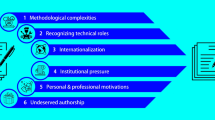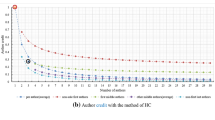Abstract
With the growth of research collaborations, the average number of authors per article and the phenomenon of equally important authorships have increased. The essence of the phenomenon of equally important authorships is the approximately equal importance of authors, both because of the difficulties in comparing authors’ contributions to a paper and some actual research evaluation practices, which (approximately) give full paper credit only to the most important authors. A mechanism for indicating that various authors contributed equally is required to maintain and strengthen collaboration. However, the phenomenon of multiple important authors can cause unfair comparisons among the research contributions and abilities of authors of different papers. This loophole may be exploited. Normalizing the credit assigned to a given paper’s authors is an easy way to solve this ethical dilemma. This approach enables fair comparisons of the contributions by the authors of different articles and suppresses unethical behaviour in author listings. Bibliometric researchers have proposed mature methods of normalized paper credit assignment that would be easy to use given the current level of computer adoption.
Similar content being viewed by others
References
Abbasi, A., & Jaafari, A. (2013). Research impact and scholars’ geographical diversity. Journal of Informetrics, 7(3), 683–692.
Abramo, G., D’Angelo, C. A., & Murgia, G. (2014). Variation in research collaboration patterns across academic ranks. Scientometrics, 98(3), 2275–2294.
Agoramoorthy, G. (2017). Multiple first authors as equal contributors: Is it ethical? Science and Engineering Ethics, 23(2), 625–627.
Bikard, M., Murray, F., & Gans, J. S. (2015). Exploring trade-offs in the organization of scientific work: Collaboration and scientific reward. Management Science, 61(7), 1473–1495.
Boh, W. F., Ren, Y., Kiesler, S., & Bussjaeger, R. (2007). Expertise and collaboration in the geographically dispersed organization. Organization Science, 18(4), 595–612.
Bornmann, L. (2017). Is collaboration among scientists related to the citation impact of papers because their quality increases with collaboration? An analysis based on data from F1000Prime and normalized citation scores. Journal of the Association for Information Science and Technology, 68(4), 1036–1047.
Bozeman, B., Gaughan, M., Youtie, J., Slade, C. P., & Rimes, H. (2016). Research collaboration experiences, good and bad: Dispatches from the front lines. Science Public Policy, 43(2), 226–244.
Chai, J. K., Hua, P. H., Rousseau, R., & Wan, J. (2008). The adapted pure h-index. In H. Kretschmer & F. Havemann (Eds.), Proceedings of WIS 2008, Berlin. Fourth international conference on webometrics, informetrics and scientometrics & ninth COLLNET meeting. http://www.collnet.de/Berlin-2008/ChaiWIS2008aph.pdf.
Clark, B. Y., & Llorens, J. J. (2012). Investments in scientific research: Examining the funding threshold effects on scientific collaboration and variation by academic discipline. Policy Studies Journal, 40(4), 698–729.
Cronin, B. (2001). Hyperauthorship: A postmodern perversion or evidence of a structural shift in scholarly communication practices? Journal of the American Society for Information Science and Technology, 52(7), 558–569.
Egghe, L., Rousseau, R., & Van Hooydonk, G. (2000). Methods for accrediting publications to authors or countries: Consequences for evaluation studies. Journal of the American Society for Information Science, 51(2), 145–157.
Fernandes, J. M., & Monteiro, M. P. (2017). Evolution in the number of authors of computer science publications. Scientometrics, 110(2), 529–539.
Frandsen, T. F., & Nicolaisen, J. (2010). What is in a name? Credit assignment practices in different disciplines. Journal of Informetrics, 4(4), 608–617.
Hagen, N. T. (2010). Harmonic publication and citation counting: Sharing authorship credit equitably–not equally, geometrically or arithmetically. Scientometrics, 84(3), 785–793.
Hagstrom, W. O. (1964). Traditional and modern forms of scientific teamwork. Administrative Science Quarterly, 9(3), 241–263.
He, B., Ding, Y., & Yan, E. (2012). Mining patterns of author orders in scientific publications. Journal of Informetrics, 6(3), 359–367.
Henriksen, D. (2016). The rise in co-authorship in the social sciences (1980–2013). Scientometrics, 107(2), 455–476.
Hicks, D., Wouters, P., Waltman, L., de Rijcke, S., & Rafols, I. (2015). The Leiden Manifesto for research metrics. Nature, 520(7548), 429–431.
Hirsch, J. E. (2005). An index to quantify an individual’s scientific research output. Proceedings of the National Academy of Sciences, 102(46), 16569–16572.
Hodge, S. E., & Greenberg, D. A. (1981). Publication credit. Science, 213(4511), 950.
Hu, X. J. (2009). Loads of special authorship functions: Linear growth in the percentage of ‘equal first authors’ and corresponding authors. Journal of the American Society for Information Science and Technology, 60(11), 2378–2381.
Hu, X. J., Rousseau, R., & Chen, J. (2010). In those fields where multiple authorship is the rule, the h-index should be supplemented by role-based h-indices. Journal of Information Science, 36(1), 73–85.
Leahey, E. (2016). From sole investigator to team scientist: Trends in the practice and study of research collaboration. In K. S. Cook & D. S. Massey (Eds.), Annual review of sociology (Vol. 42, pp. 81–100). Palo Alto, CA: Annual Reviews.
Lee, S., & Bozeman, B. (2005). The impact of research collaboration on scientific productivity. Social Studies of Science, 35(5), 673–702.
Liu, X. Z., & Fang, H. (2012a). Fairly sharing the credit of multi-authored papers and its application in the modification of h-index and g-index. Scientometrics, 91(1), 37–49.
Liu, X. Z., & Fang, H. (2012b). Modifying h-index by allocating credit of multi-authored papers whose author names rank based on contribution. Journal of Informetrics, 6(4), 557–565.
Liu, X. Z., & Fang, H. (2014). Scientific group leaders’ authorship preferences: An empirical investigation. Scientometrics, 98(2), 909–925.
Lukovits, I., & Vinkler, P. (1995). Correct credit distribution: A model for sharing credit among coauthors. Social Indicators Research, 36(1), 91–98.
O’Brien, T. L. (2012). Change in academic coauthorship, 1953–2003. Science, Technology and Human Values, 37(3), 210–234.
Presser, S. (1980). Collaboration and the quality of research. Social Studies of Science, 10(1), 95–101.
Price, D. J. D. (1963). Little science, big science. New York: Columbia University Press.
Price, D. J. D. (1981). Multiple authorship. Science, 212(4498), 986.
Qin, J. (1994). An investigation of research collaboration in the sciences through the philosophical-transactions 1901–1991. Scientometrics, 29(2), 219–238.
Rawlings, C. M., & McFarland, D. A. (2011). Influence flows in the academy: Using affiliation networks to assess peer effects among researchers. Social Science Research, 40(3), 1001–1017.
Rennie, D., Yank, V., & Emanuel, L. (1997). When authorship fails: A proposal to make contributors accountable. The Journal of the American Medical Association, 278(7), 579–585.
Schreiber, M. (2008a). To share the fame in a fair way, h m modifies h for multi-authored manuscripts. New Journal of Physics, 10, 040201.
Schreiber, M. (2008b). A modification of the h-index: The h m-index accounts for multi-authored manuscripts. Journal of Informetrics, 2(3), 211–216.
Shi, X., Adamic, L. A., Tseng, B. L., & Clarkson, G. S. (2009). The impact of boundary spanning scholarly publications and patents. PLoS ONE, 4(8), e6547.
Smith, M. (1958). The trend toward multiple authorship in psychology. American Psychologist, 13(10), 596–599.
Stallings, J., Vance, E., Yang, J., Vannier, M. W., Liang, J., Pang, L., Dai, L., Ye, I., & Wang, G. (2013). Determining scientific impact using a collaboration index. Proceedings of the National Academy of Sciences of the United States of America, 110(24), 9680–9685.
Teixeira da Silva, J. A., & Dobránszki, J. (2016). Multiple authorship in scientific manuscripts: Ethical challenges, ghost and guest/gift authorship, and the cultural/disciplinary perspective. Science and Engineering Ethics, 22(5), 1457–1472.
The Optical Society. (2012). Publishing your manuscript. http://opticsinfobase.org/submit/review/PubBrochEnglish-April-2012.pdf. Accessed June 2017.
Van Hooydonk, G. (1997). Fractional counting of multiauthored publications: Consequences for the impact of authors. Journal of the American Society for Information Science, 48(10), 944–945.
Van Wesel, M. (2016). Evaluation by citation: Trends in publication behavior, evaluation criteria, and the strive for high impact publications. Science and Engineering Ethics, 22(1), 199–225.
Waltman, L. (2012). An empirical analysis of the use of alphabetical authorship in scientific publishing. Journal of Informetrics, 6(4), 700–711.
Wan, J. K., Hua, P. H., & Rousseau, R. (2007). The pure h-index: Calculating an author’s h-index by taking co-authors into account. COLLNET Journal of Scientometrics and Information Management, 1(2), 1–5.
Warrender, J. M. (2016). A simple framework for evaluating authorial contributions for scientific publications. Science and Engineering Ethics, 22(5), 1419–1430.
Washburn, J. J. (2008). Encouraging research collaboration through ethical and fair authorship: A model policy. Ethics and Behavior, 18(1), 44–58.
Winston, R. B. (1985). A suggested procedure for determining order of authorship in research publications. Journal of Counseling and Development, 63(8), 515–518.
Wray, K. B. (2002). The epistemic significance of collaborative research. Philosophy of Science, 69(1), 150–168.
Wray, K. B. (2005). Rethinking scientific specialization. Social Studies of Science, 35(1), 151–164.
Wren, J. D., Kozak, K. Z., Johnson, K. R., Deakyne, S. J., Schilling, L. M., & Dellavalle, R. P. (2007). The write position. EMBO Reports, 8(11), 988–991.
Zhou, P., & Leydesdorff, L. (2008). China ranks second in scientific publications since 2006. ISSI Newsletter, 4(1), 7–9.
Author information
Authors and Affiliations
Corresponding author
Appendix
Appendix
Two examples of papers with multiple first authors and corresponding authors (Hu 2009):
Example 1. The following paper has 11 authors, nine of whom are equal first authors and one of whom is a corresponding author:
A. Abbing*, U.K. Blaschke*, S. Grein*, M. Kretschmar*, C.M.B. Stark*, M.J.W. Thies*, J. Walter*, M. Weigand*, D.C.Woith*, J. Hess¶, C.O.A. Reiser (2004). Efficient intracellular delivery of a protein and a low molecular weight substance via recombinant polyomavirus-like particles. Journal of Biological Chemistry, 279, 27410–27421.
*These authors contributed equally to this work.
¶To whom correspondence should be addressed.
Example 2. The following paper has three co-first authors and four corresponding authors:
M. Kolisek,1* P. Launay,1* A. Beck,1 G. Sponder, N. Serafini, M. Brenkus, E.M. Froschauer, H. Martens, A. Fleig* and M. Schweigel* (2008). SLC41A1 is a novel mammalian Mg2 + carrier. Journal of Biological Chemistry, 283, 16235–16247.
1These authors contributed equally.
*To whom correspondence may be addressed.
Rights and permissions
About this article
Cite this article
Fang, H. Normalized Paper Credit Assignment: A Solution for the Ethical Dilemma Induced by Multiple Important Authors. Sci Eng Ethics 24, 1589–1601 (2018). https://doi.org/10.1007/s11948-017-9973-4
Received:
Accepted:
Published:
Issue Date:
DOI: https://doi.org/10.1007/s11948-017-9973-4




